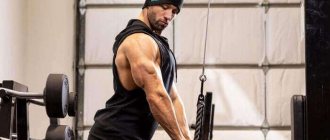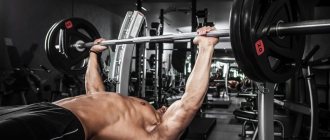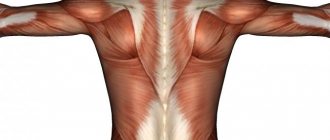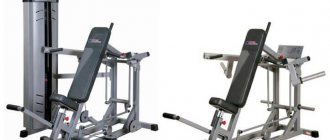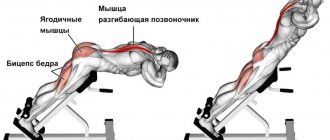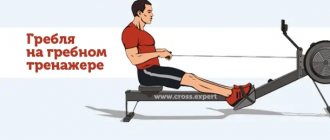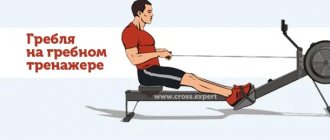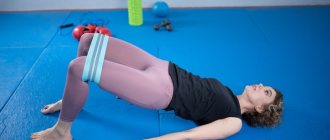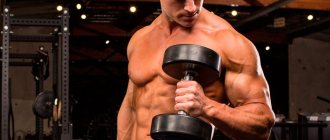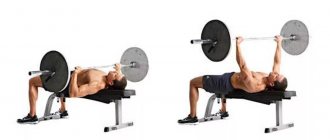Pullover (or pullover) with a dumbbell is an exercise for the back muscles. Many people mistakenly think of it as a movement for the chest, shoulders, or trapezius, but this is not the case. A simple exercise entered the history of bodybuilding thanks to the “Lyubertsy” training system. It used movement to “expand” the chest. The effect was achieved by correcting posture and developing the chest muscles, and not by changing the bone structure. Today, pullovers are sometimes included in fitness programs, sometimes removed from them, as they are considered traumatic. When done correctly, it can only be useful. And for those who cannot work with a dumbbell, there is the option of moving while standing in an incline with a block exercise machine.
Why the pullover exercise has lost popularity
In 1914, THE HISTORY OF THE DUMBBELL PULLOVER was even printed on cards in cigarette packages, and the founding father of American strength training, Alan Calvert, considered the Super Strength Paperback exercise the best way to increase chest size.
In the mid-20th century, the pullover was used by such famous bodybuilders as Randy Roach, Bob Hoffman, Joe Weider and Reg Park, but in the 90s the exercise suddenly began to be considered not especially effective and even dangerous.
For example, Dr. Joseph Horrigan, a sports medicine expert from the University of Southern California, wrote an article Complications of the pullover (1990) - Joseph Horrigan that the exercise can cause hernia and injuries to the back and shoulders.
Contraindications
To exercise in the gym using the pullover exercise, you must have a strong cardiovascular system, developed respiratory organs and good endocrine glands.
Contraindications for which pullover exercise is prohibited:
- Tumors of benign or malignant type.
- Pathological manifestations of articular ligaments.
- Damage to the back and spine.
- Severe forms of scoliosis.
- Psychical deviations.
- Hypertension.
- Chronic or acute gastrointestinal diseases.
Visiting the hall is also prohibited for persons who have suffered a heart attack or stroke. If you have a traumatic brain injury, you can engage in physical activity only after 2-3 years, having previously passed the necessary tests.
Can exercise really cause injury?
In his article, Joseph Horrigan argues that the pullover can be harmful if performed with only your shoulders resting on the bench and bending your body too much.
Due to the stretching and relaxation of the muscles during inhalation, this performance can lead to injury to the linea alba—the strip of connective tissue between the two rows of “cubes”—and cause a hernia.
View this post on Instagram
Posted by Carina Isaksson /Onlinecoach (@carinaisaksson)
It is worth noting that there are neither studies nor isolated cases of such injuries described in scientific publications. Therefore, we cannot say with certainty that such execution can actually cause harm. Moreover, it is still used by famous strength coaches.
Horrigan also argued that if a person has limited shoulder mobility, performing pullovers with heavy weights can injure the rotator cuff structures and back muscles.
Indeed, your shoulders are in a very disadvantageous position under load. And if you overdo the weight or try to push past your range of motion, you could get injured.
However, all you need to avoid this is not to struggle with the weights and perform the pullover only in the range for which your shoulders are ready.
Basic mistakes
Dumbbell weight too heavy
Never lift a weight you can't control! Especially when performing such a traumatic exercise as a pullover with a dumbbell. If you pick up a heavy dumbbell, you will not be able to perform the exercises perfectly. Consequently, there can be no talk of any weight control. This will eventually lead to serious shoulder injury. And also at the moment of lowering, the weight can pull you along with it. Which will lead to falling off the bench.
Large range of motion
Of course, the amplitude of movement plays a very important role. And the larger it is, the better the return from the exercise. But everything must be in moderation. Therefore, you should not try to reach the dumbbell to the floor at the moment of lowering. This will only overload the shoulder joint. The same goes for lifting. There is no need to move the dumbbell all the way to the pelvis at the top point. This will not affect the work of the lats or pecs in any way. But it will put a lot of stress on the front delta.
Turning the exercise into a French press
When performing a pullover, we slightly bend our arms at the elbow joint (with an emphasis on the back, an angle of 90° is allowed). And they should be in this position throughout the entire execution. Some people do not follow this rule and begin to bend their arms even more while lowering. And when lifting, the arms are fully straightened. Thus, exercises are performed using the triceps. But our target muscles are completely different.
What pumps up the pullover exercise
We were able to find two studies of the pullover using electromyography (EMG), a measurement of the electrical potential in the working muscle.
In one Effects of the pullover exercise on the pectoralis major and latissimus dorsi muscles as evaluated by EMG, scientists found that during a pullover with a barbell, activity in the latissimus dorsi muscles is only 10% of what occurs in the pectoral muscles.
But it won’t be possible to recognize it as one of the best for breast pumping. In another (PDF) Comparison of electromyographic activity during the bench press and barbell pullover exercises experiment, the pullover was compared with the bench press and saw that the latter loaded both heads of the pectoralis major muscles twice as much.
With the lats, the effect was the opposite: the pullover pumps up the back muscles much more than the bench press. But it won’t be possible to recognize it as the best for pumping up the back either, since pull-ups load Surface electromyographic activation patterns and elbow joint motion during a pull-up, chin-up, or perfect-pullup™ rotational exercise on the lats 1.5–2 times more.
The pullover pumps up both the pectoral and latissimus dorsi muscles, but not as well as other exercises.
By the way, there is a theory that it was abandoned precisely for this reason. Since splits—a rigid division of the body into muscle groups—became popular in the field of bodybuilding, it became unclear what the pullover exercise should be classified as. And as a result, it gradually faded into the shadows.
Pros and cons of the exercise
The dumbbell pullover exercise is a technically difficult movement. Therefore, its main disadvantage is considered to be difficulty in mastering . This was also one of the reasons for its low popularity in gyms.
If performed incorrectly, the movement will not only not give the desired effect, but also poses an increased risk of injury.
Also a conditional disadvantage is the involvement of three muscle groups. Therefore, it is necessary to do pullovers so that the working muscles have time to recover before the next workout.
However, when mastering the technique, the athlete receives a number of tangible benefits:
- High-quality work on the pectoral muscles while simultaneously stretching the muscles (especially useful for those who experience problems with posture due to shortening of the pectoral muscles and overstretching of the back muscles).
- Pumping the latissimus muscles.
- Powerful load on the long head of the triceps.
- The ability to work with heavy weights without the risk of injury.
- Pronounced development of strength indicators.
Why do the pullover exercise?
Although the pullover is not the best exercise for either the chest or back, there are several reasons to include it in your workouts.
Providing an unusual stimulus for muscle growth
A pullover can be used at the end of a workout to fully fatigue the muscles and provide them with a stimulus for growth.
Since most chest exercises involve horizontal shoulder adduction (bench press, fly press, hammer press), flexion and extension will be an unusual stimulus and can stress muscle fibers that are not engaged in standard movements.
The same applies to the latissimus dorsi muscles. Unlike pull-ups and other pull-ups, pullovers stretch under load, which can also provide an unusual stimulus and push them to grow.
Development of mobility of the shoulder joints
Maximum shoulder extension with weights will help increase your range of motion, which can be useful in any exercise that requires you to exert force with your arms overhead.
However, to avoid injury, you should start with light weights. Incorrect weight selection and forced attempts to overcome your range can result in injury.
Improve sports performance and reduce the risk of injury
The study noted (PDF) Comparison of electromyographic activity during the bench press and barbell pullover exercises that because the pullover simultaneously targets both the lats and pectoral muscles, as well as the serratus anterior, triceps, and abs, it can teach the body to transfer forces between these muscles more effectively. muscle groups.
This could potentially improve performance in sports like tennis, baseball, or volleyball—anything that requires effort with your arms raised above your head.
In addition, such training can reduce the risk of shoulder injuries.
Advantages and disadvantages
Analyzing what the pullover exercise does, it should be noted that it will be especially useful for women. If the pullover is technically correct, it has the following effects:
- on the pectoral muscles, stretching their upper parts, helping the female breasts acquire elasticity and firmness,
- on the triceps - another problem area of the female figure,
- latissimus muscles, stretching them, strengthening the back,
- straight abdominal muscles.
In addition, the small and deltoid muscles of the back and the serratus anterior muscle are involved.
Pullover is classified as an exercise of medium difficulty, and due to the weak overall load on the muscles, it is classified as an isolated exercise. If we consider the table with the load exerted on the muscles when performing a pullover and assessed on a 10-level scale, the following comes out:
| Latissimus muscles | 8 |
| Pectoral muscles | 3 |
| Triceps | 3 |
These indicators do not allow you to practice the pullover as a central exercise in the training program. Its task is only to enhance the effect of squats, bench press, and deadlift. By introducing it into the training program, it is quite possible to:
- strengthen the muscular frame and shoulder joints,
- increase the volume of the chest,
- emphasize muscle relief.
Failure to comply with the pullover technique, or its incorrect execution, leads to overload of the cartilage of the shoulder joint, which leads to the need to take a break from training for up to 6 months. A good warm-up, precise execution maintaining amplitude, and the use of light weights will help you avoid this problem.
When performing a pullover while lying down on a bench, you should make sure that your head rests on the bench, otherwise the exerted load can cause a neck strain and the appearance of chronic pain.
According to some representatives of sports medicine, performing a pullover while lying on a bench, without back support, can negatively affect the abdominal wall.
How to do the pullover exercise for different purposes
The execution rules depend on what goals you want to achieve. We will present several options.
To practice the movement with your arms above your head
If your main goal is to improve the transfer of force between your chest and back muscles, strengthen them, and reduce the risk of injury in overhead movements, try the following variation.
Take a dumbbell in your hands and lie down on a bench so that your head is on its edge. Press your feet to the floor, grab the dumbbell by the weight plate with both hands, palms facing away from you, and straighten your arms.
Extend your shoulders until they are parallel to your body. Don't intentionally bend your elbows, but don't lock your joints in a straight position either. Let them remain slightly bent for comfort.
If you have mobile shoulders, you can lower the dumbbell below the level of the bench, but do not try to do this if you are experiencing discomfort, much less pain: this can injure the shoulder joint.
When you reach the end of your range, bend your shoulders, returning the dumbbell to the starting position above your chest, and repeat the exercise.
For breast pumping
To put more stress on the chest, trainers advise performing pullovers in a limited range. Lie down on a bench, pick up a dumbbell and lift it above your chest.
Lower the dumbbell behind your head, but not too far. Do not try to stretch your shoulders as much as possible - stop before reaching parallel with the bench.
Bend your shoulders, returning the dumbbell to a position just above your chest, no further. At the extreme point, your arms should remain slightly inclined - this will ensure constant tension in the chest muscles.
To focus on the back muscles
Physiotherapist and creator of the Athlean-X program Jeff Cavaliere and powerlifter and author of the Pre-script course for athletes and coaches Jordan Shallow say that you can increase the load on your back if you perform the movement perpendicular to the bench with a back arch. .
Both trainers explain that the latissimus muscles are attached from below to the sacrum and ilium, and therefore the further the pelvis is from the shoulders, the more the back muscles will stretch and the stronger their stimulation will be.
To perform a pullover in this version, lean your back on the bench in the area of the shoulder blades and push your pelvis up so that your body from your shoulders to your knees is extended in one line. Then lower your arms with the dumbbell down and at the same time push your pelvis towards the floor, arching your body and stretching the latissimus muscles.
When you reach the limit of your range, return to the starting position by lifting your pelvis again. Do not change the position of your elbows throughout the movement - keep them straight and do not spread to the sides.
Perform the exercise smoothly and under control and pay attention to the sensations. If you experience discomfort or pain in your shoulders or abdominal muscles, eliminate the movement from your workout.
Recommendations for implementation
- Check the condition of the dumbbell you are going to work with. If the pancakes on it are poorly secured, then take another one.
- If you experience pain in your shoulders when lowering a dumbbell behind your head. This means you took too much weight, or lowered the dumbbell too much.
- Be sure to bend your elbows at least a little. This will take the stress off your joints.
- Before you begin the exercise, make sure that your body is firmly fixed on the bench.
- Avoid inertial and jerky movements. This way you will only injure your shoulders and will not get results.
- Control your movements and breathing.
- When working with heavy weights, do not pick up the dumbbell yourself from the floor. Ask your partner to serve it to you. If you are studying alone, then I think anyone in the room will not refuse help.
- Do not stand on your toes while lowering the dumbbell behind your head. This will break your stability. And will lead to loss of balance.
- Athletes who have any injuries or problems with the spine are better off giving up pullovers altogether. You will only make your situation worse.
What equipment can you use to perform the pullover exercise?
Choose weights based on what is currently available in the gym and what is more comfortable for you to perform the movement with.
With a barbell
Grab the barbell with an overhand grip slightly narrower than your shoulders and perform the pullover through the full range. You can also try a curved EZ bar, which will make it easier for you to keep your hands closer together.
With pancake
The plate allows you to perform a pullover with a neutral grip, which in the long term can increase the load on the back muscles.
In the crossover
Move the bench to the lower block, lie down on it and grab the handle with both hands. Bend your shoulders until your arms are at a right angle with your body and return back.
The same can be done with an expander, if you attach the elastic band to a stable support closer to the floor.
View this post on Instagram
Posted by FitPlan (@fitplansk)
Pullover for women and men
Women are afraid to do chest pullovers so as not to gain masculine muscularity. This will not happen due to the characteristics of the female body. At the same time, training the pectoralis and serratus muscles will tighten your chest.
For men, exercise increases chest volume, broadens shoulders, and improves posture. It is useful for teenagers and young adults with a sunken chest. To get a powerful upper body line, it is recommended to start training at the age of 15.
How to choose weight, number of approaches and repetitions
If you have never tried the pullover exercise, first take a very light weight and try doing it with different equipment: dumbbell, barbell, EZ bar.
If this does not cause shoulder discomfort, you can add weight. But here it is important not to overdo it. Select a weight for 12–15 repetitions that will make your muscles feel tired at the end of the exercise. Do 3-5 approaches.
Focus on 30% of your body weight, but adjust the load to suit your capabilities and sensations.
Inclusion in the training program
If you are doing the classic version for the back, then you can safely put the pullover at the beginning of the workout, second or third. It is better to work in strength mode for 6-10 repetitions in 3-4 approaches. In this case, the first one should be a warm-up.
As for pullovers with an emphasis on the chest, I have already expressed my opinion. For beginners, it is better not to use this exercise at all. And professionals mostly leave a place for it at the end of the workout. And they work in a large rep range of 15-20 in 3-4 sets. Sometimes they insert it into sets, for example, doing bench presses, and immediately after them pullovers.
For those who want to test the veracity of the theory about increasing chest volume, it is better to do pullovers along with squats. It is heavy squats that make us breathe very intensely. Due to this, the chest will expand. Therefore, doing pullovers will come in handy. Take a medium-sized dumbbell and do 3-4 sets of 10-15 repetitions. That is, we squatted with a barbell, immediately did pullovers, and so on for each approach.
As you can see, dumbbell pullovers can be a very beneficial exercise for developing a large number of muscles. The main thing is to correctly insert this exercise into your training program. And use the right technology.
Good luck to everyone in your training!
Week schedule
You should definitely start training in the gym or at home with a simple warm-up. Just a couple of exercises to help your muscles warm up and be ready for serious work.
You should train at least 3 days a week and the training process itself may include the following tasks:
| Monday | Warm-up – 5 min. Afterwards, make 3 types of pullover. Add other exercises if you need to work other muscles. At the end, be sure to stretch for 5 minutes to allow the muscles to recover. | The first day will be enough for 1 approach and 5-6 repetitions each. |
| Wednesday | Warm up. The main set of exercises, including all three types of pullovers and stretching at the end. | The second workout involves 2 approaches and 7 times each. |
| Friday | Stretching. Main complex. Stretching. | Perform each type of pullover 2-3 times and up to 8 times each. |
The workout can be diluted with any exercises to effectively work all muscle groups and increase endurance. Don't forget about warming up and stretching, because they will help protect your muscles from injury, as well as relieve pain after serious exercise. Follow these tips regardless of whether the training takes place in the gym or at home.
Kettlebell push-ups
Push-ups can be performed in two variations: with your hands pressed to your body, and also with a wide stance. The wider the position of the arms, the more the chest muscles are activated. In the narrow version, the triceps are loaded more.
Technique:
- Place the weights wide apart, about arm's length apart for a regular push-up. The arms should be perpendicular to the body.
- Place your torso between the weights and grab the handles with both hands. Get into a plank position, keeping your entire body in a solid line.
- As you inhale, bend your elbows and lower your torso as low as possible, hanging above the floor.
- Exhale and push up, fully straightening your elbows at the top.
Lying down one-arm kettlebell raises
This is an alternative to alternate kettlebell raises and is suitable for those who only have one kettlebell at their disposal. You also don't need a bench for this exercise.
Technique:
- Lying on your back, grab the bar of a kettlebell with an underhand grip and press your elbow toward your torso, keeping your forearm vertical. At the lowest point, the weight is located on the outside of the forearm, and the angle at the elbow remains straight. The inner side of the palm is turned towards the body.
- With an exhalation, press the weight upward, supinating the wrist joint, that is, turn the hand towards the feet. At the top point, the elbow is fully straightened.
- As you inhale, slowly return your shoulder to the floor.
Repeat the same on the other hand.
And also read: All exercises for the chest → 7 exercises with a kettlebell for the back → 5 exercises with a kettlebell for the shoulders → Exercises with a kettlebell for the triceps → Exercises for biceps with a kettlebell → 20 exercises with a kettlebell for all muscles →
